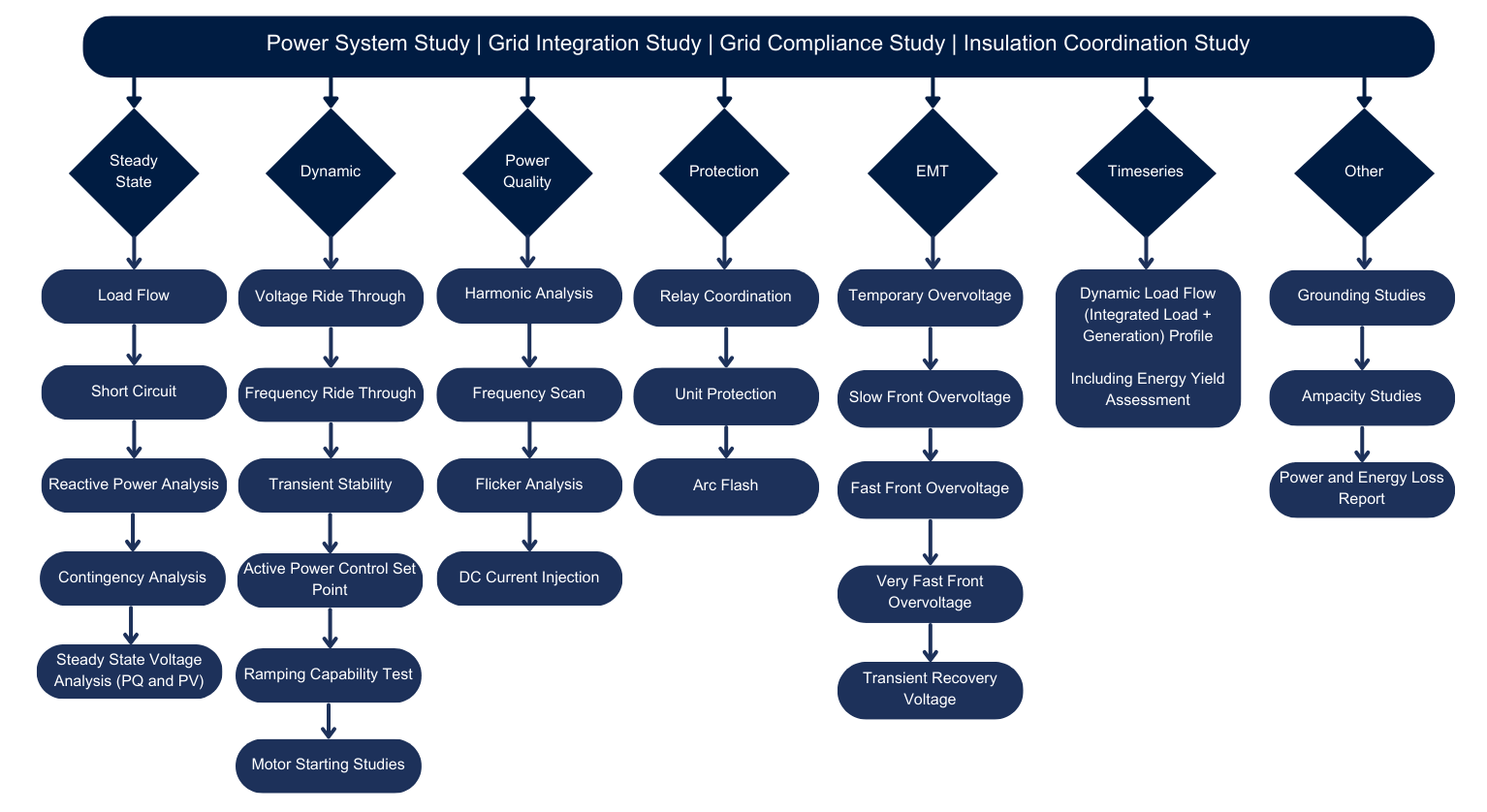Power System Studies
Home / Services / Power System Studies
power system studies consultant in india | Power System studies companies in India | Best power system studies companies in india
Solar power plant Consultants in India | Top Solar consultants in India | Solar consultancy services in India | Top 10 engineering Consultants in India | Top solar consultancy services in india | Solar power plant Consultants in India | Best solar power plant consultants in india
Power System Studies Consultants in India
The Rise of Renewables and Aging Infrastructure Challenge the Grid
The electrical grid is undergoing a major transformation driven by several factors :
- A surge of inverter-based renewable energy sources like solar and wind.
- An aging grid infrastructure.
- Increased power consumption from data canters, industrial facilities, and technological advancements.
Planning for a Reliable and Cost-Effective Power System
Effective power system planning is crucial at every stage of a project, from initial concept and feasibility studies to detailed engineering. This ensures that new generation, transmission, and distribution projects minimize impact on existing infrastructure while considering future needs.
QQEC : Your Partner in Comprehensive Power System Planning
At QQEC, we possess a deep understanding of generation, transmission, and distribution across the entire power system. We leverage this expertise to help clients plan reliable, cost-effective power systems that meet the goals of all stakeholders.
Complete Suite of Power System Studies


Steady State Studies
Steady-state power system studies are a crucial component in ensuring the reliable and efficient operation of electrical grids, generation plants, and local distribution facilities.
These studies analyze the behaviour of the power network under various operating conditions.
Load Flow Studies
Load flow studies are conducted to understand the voltage profile at each bus, equipment loading, transformer tap changer limit adequacy, voltage drop, and power losses.
Short Circuit Studies
Short circuit studies are performed to determine the magnitude of short-circuit currents under different fault conditions, such as three-phase, line-to-ground, line-to-line, and line-to-line-to-ground faults. This information is used to select the optimal size of switchgear and switchboards, ensuring the devices can withstand the fault current.
Reactive Power Analysis
Reactive power analysis is carried out to estimate the need for reactive power compensation in order to satisfy grid code requirements.
Contingency Analysis
Contingency analysis is performed to understand the effect of the outage of any element in the power system and to check for any loading limit violations or voltage issues on the remaining equipment.
Steady-State Analysis
Steady-state analysis, including PQ and PV curve studies, is conducted to understand the optimal power flow, voltage variations, and the need for reactors in long-transmission line applications.
By leveraging our expertise in these steady-state power system studies, QQEC helps clients plan and operate their electrical infrastructure reliably, efficiently, and in alignment with industry standards and grid requirements.
Value Addition and Optimization Approach :
Approach for Transformer Impedance Selection :
We leverage both short-circuit studies and reactive power analysis to optimize the impedance of your power transformers. This ensures they meet your project’s specific needs while considering future growth.
Beyond Traditional Sizing: Optimizing Transformers for Renewables:
Traditionally, power transformer sizing considers project capacity and reactive power needs. We go beyond traditional methods by factoring in the intermittent duty of renewable plants. Our deep understanding on energy generation pattern of particular project location with particular technology along with applicable code and standard allows us room of power transformer optimization.
Switchboard Optimization with Confidence:
By optimizing transformer impedance and incorporating realistic models of transmission lines, cables, and future growth factors of short circuit current, we can ensure your switchboards have the optimal short-circuit rating meeting all code and compliance.
Data-Driven Selection of Reactive Power Equipment:
We consider project scale and conduct in-depth code and standard reviews to recommend the most suitable equipment, be it inverters, PCS (power conversion systems), STATCOMs (static synchronous compensators), or SVGs (static var generators).
Dynamic Studies
The Challenge of Grid Stability in a Changing Landscape
Power systems are inherently susceptible to disturbances. These can arise from various factors, including:
- Faults within the system itself.
- Sudden changes in voltage or frequency due to load fluctuations or generation loss.
- Other unforeseen events.

Understanding how the power system responds (system response) and maintains stability during such disturbances is crucial for power engineers. This challenge becomes even more significant with the increasing penetration of inverter-based renewable resources like solar and wind. These resources can introduce new complexities into grid dynamics.
Grid Codes: Ensuring Stability Standards
To maintain a reliable and stable grid, each country establishes grid codes. These codes define the expected dynamic responses within the network and from generation plants during disturbances. By adhering to these codes, power engineers ensure their systems can effectively handle disruptions and maintain power quality.
In essence, understanding power system stability and system response is paramount for navigating the complexities of an evolving grid with a growing share of renewable energy sources. Grid codes provide a crucial framework for achieving this stability and ensuring a reliable power supply.
Modelling and Simulation :
QQEC Team possess expertise to model renewable plant and grid network in RMS and EMT tool in line with Load Dispatch Centre (LDC) / Transmission Service Operator (TSO) requirement. QQEC Team can support client in:
- High voltage ride through studies.
- Low voltage ride through studies.
- Frequency ride through studies.
- Transient stability studies.
- Ramping capability test.
QQEC team supports client in benchmarking studies through comparison of RMS and EMT studies.

Power Quality Studies
Power quality refers to the consistency and stability of the electrical power delivered to consumers. It’s essentially a measure of how “clean” the power is.
Increasing reliance on sensitive electronic equipment, growth of renewable energy and aging grid infrastructure are key contributors to power quality issues.
Power quality issues may result equipment malfunction and damage, operational disruptions and productivity loss, flickering lights and safety hazard.
Power quality covers harmonic, flicker and DC current injection as primary sources.
Grid code defines limit of power quality. IEEE 519, IEEE 2800, IEEE 1547, IEC 61727 and IEC 61000 standard defines power quality limit.
QQEC Team also support client through field testing and performing benchmarking studies.
Protection Studies & Arc Flash
Protection coordination ensures reliable, safe, and efficient operation of electrical grids. QQEC team possess expertise for protection coordination.
- Relay coordination for overcurrent and earth fault protection.
- Unit protection.
Keep Your Grid Running Smoothly: Expert Protection Coordination by QQEC
Reliable, safe, and efficient power depends on a well-protected electrical grid. The QQEC team offers unmatched expertise in protection coordination, ensuring your grid functions flawlessly.

- Relay coordination: We fine-tune protective relays for optimal response to overcurrent and earth fault situations. This minimizes equipment damage and ensures fast isolation of faults, preventing widespread outages.
- Unit protection: Our team provides specialized protection schemes for critical equipment within your grid, safeguarding them from even the most specific faults.
With QQEC's protection coordination services, you can experience :
- Enhanced grid reliability: Minimize downtime and ensure consistent power delivery.
- Improved safety: Protect personnel and equipment from electrical hazards.
- Increased efficiency: Optimize grid operations for maximum performance.
What is Arc Flash?
An arc flash is a dangerous electrical phenomenon that occurs when an electric current jumps uncontrollably through air due to a fault in the electrical system. It’s essentially a miniature electrical explosion that releases intense heat, light, and a pressure wave.
The main purpose of an arc flash study is to proactively enhance worker safety around electrical equipment. It achieves this by :
- Identifying Risks : The study recognizes areas within a facility that pose potential dangers from arc flashes. Arc flashes are sudden, intense bursts of heat and light that can cause severe burns, shrapnel wounds, and even death.
- Quantifying Severity : It estimates the incident energy, which is the amount of thermal energy released during an arc flash event. This helps assess the potential severity of an injury a worker might sustain.
- Recommending Safeguards : Based on the incident energy levels, the study recommends appropriate Personal Protective Equipment (PPE) for workers. This PPE could include arc-rated clothing, face shields, and gloves to shield them from the intense heat and light of an arc flash.

Insulation Coordination Studies (Emt- Electro Magnetic Transient)
Keeping Electrical Systems Safe and Reliable: The Role of Insulation Coordination Studies
Insulation coordination studies are crucial for ensuring the safe and reliable operation of electrical systems. These studies involve checking two key things :
- The strength of the insulation on electrical equipment (called the Basic Insulation Level or BIL).
- The effectiveness of surge arrestors in protecting against voltage spikes caused by various events.
Types of Voltage Spikes Analyzed :
The studies consider different types of voltage spikes that can occur in a system :
- Temporary Overvoltages (TOV) : These are longer-duration voltage increases caused by events like ground faults, sudden load changes, or the Ferranti effect.
- Slow Front Overvoltages (SFO) : These are voltage spikes with a gradual rise, typically caused by switching operations like energizing transformers or lines. Studies ensure both the surge arrester and equipment insulation can handle these surges.
- Fast Front Overvoltages (FFO) : These are rapid voltage spikes caused by direct lightning strikes or flashover (electrical discharge) due to weather. The studies verify the adequacy of surge arrestors and equipment BIL for such lightning surges.
- Very Fast Front Overvoltages (VFFO) : These are extremely rapid voltage spikes unique to switching operations within gas-insulated substations (GIS).
- Transient Recovery Voltage (TRV) : Studies assess the circuit breaker’s ability to handle the TRV, which is the voltage that appears across the breaker contacts after it interrupts a fault current.
By analyzing these different voltage spikes, insulation coordination studies help ensure electrical equipment is properly protected and the entire system operates reliably.
Time Series Load Flow
Matching Supply and Demand: Challenges and Solutions in Integrating Renewables and Distributed Resources
Adding distributed energy resources (DERs) and large-scale renewable projects to the grid brings a new set of considerations, especially when it comes to managing the flow of electricity (dispatch).
Understanding the Power Picture
To effectively integrate these resources, a technique called time-series load flow analysis (also known as quasistatic load flow) is used. This analysis helps us understand several key factors:

- Generation patterns of different renewable resources like solar and wind.
- Charging and discharging behaviour of energy storage systems.
- Electricity demand patterns throughout the day.
By visualizing these factors as superimposed curves, we gain valuable insights for :
- Optimizing equipment size : We can ensure electrical equipment is sized appropriately to handle the variable power flow from DERs and renewables.
- Planning outages : We can strategically plan maintenance and repairs to minimize disruption when DERs and renewables are not generating.
- Identifying storage needs : The analysis helps determine the storage capacity and cycling requirements to balance supply and demand effectively.
- Accounting for seasonal effects : We can factor in how both electricity demand and renewable generation vary throughout the year.
By utilizing time-series load flow analysis, we can integrate DERs and renewables more smoothly, ensuring a reliable and efficient power grid.

Other Studies
QQEC team expertise in power system studies. This includes studies required at Engineering stage essentially:
- Grounding studies.
- Ampacity studies.
- Voltage drop and power loss.
Grounding Studies :
- QQEC uses advanced techniques like multilayer soil modelling to precisely calculate step and touch potentials, ensuring personnel safety around electrical equipment.
- These studies are especially valuable for substations or plants with limited space, high short-circuit currents, or high soil resistivity.
- Performing grounding studies with specialized tools helps optimize the amount of earthing material required for a cost-effective and safe design.
Ampacity Studies :
- Ampacity studies determine the safe current-carrying capacity of cables considering specific site conditions.
- We factor in cable installation type (underground or aboveground), ambient temperature, soil thermal resistivity, and cable layout (trenches, conduits, or trays).
- Section modelling considering above aspects in software and analyse results.
- By analyzing these various scenarios and accounting for loading factors (especially for renewable energy plants), ampacity studies provide the most accurate cable size requirements for your project.
- This technique optimize cable ampacity specifically for harsh environmental conditions where temperature is high, soil is dry and having higher thermal resistivity.
These are just a few examples of QQEC’s expertise in power system studies. By partnering with us, you can ensure your electrical system is designed to meet all safety, efficiency, and reliability standards.
